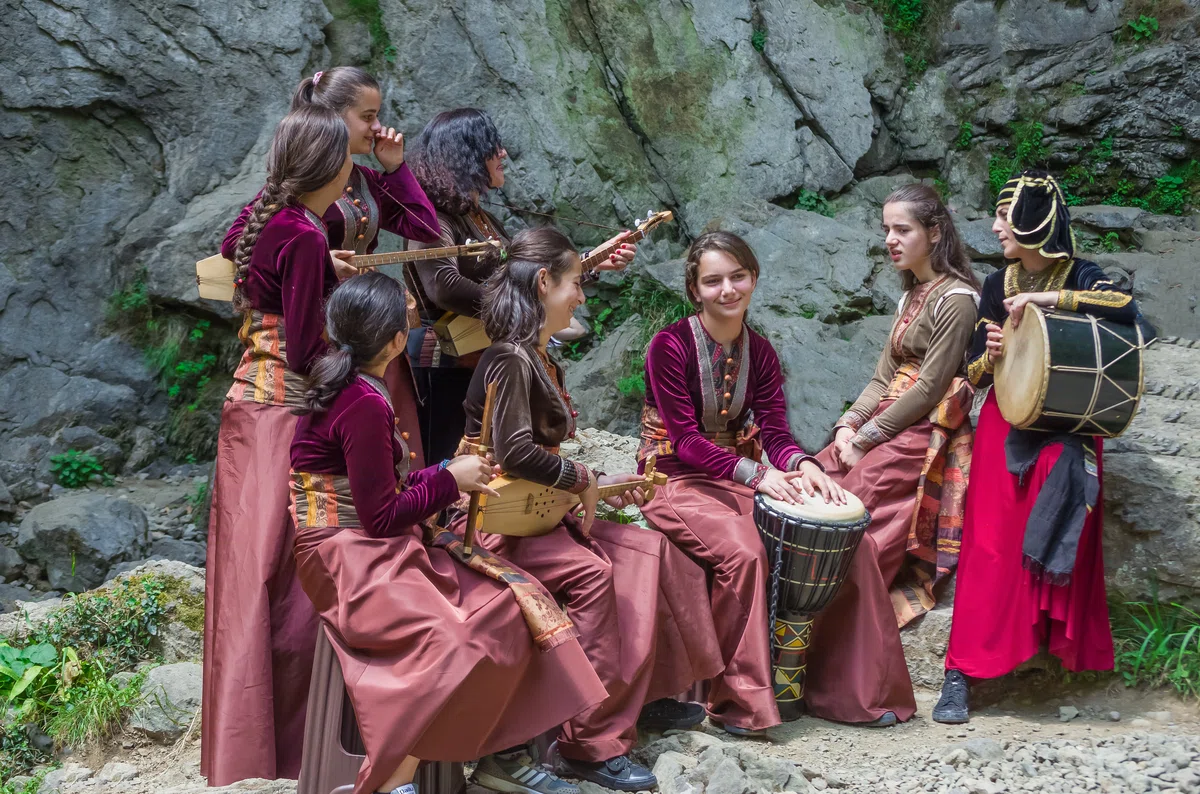
Georgian national folk instruments. Wind, string, and keyboard musical instruments.
Georgian national musical instruments include the Salamuri as the earliest, and the most popular ones such as Panduri, Doli, Harmon, Chonguri, Chiboni, and Gudastviri. Local instruments are unique and popular even beyond the country's borders. Since 1975, there has been a museum of Georgian folk instruments in Tbilisi.
All about the national musical instruments of Georgia⬇️
Since ancient times, humans have been surrounded by various sounds of nature. The sound of rain, the rustling of grass in fields, the melodious chirping of birds, and the buzzing of insects. Over time, people noticed that each sound evokes a different emotion. Sometimes people wake up early in the morning and take a walk in the local park just to enjoy the beautiful singing of birds. We have learned to understand that every sound has its own mood - sad, happy, dreamy, and so on. Often, a melody can motivate us to take some new action, or it can completely immerse us in our thoughts and feelings.
It is precisely the sounds of our surrounding environment, especially the sounds of nature, that have inspired humans to create musical instruments. This gave rise to the most common and widespread form of folk art among all nations - traditional music. Music is indeed very important for children. Through music, children learn to listen and understand correctly, develop their creative abilities. Often, children who grew up listening to and loving music become outstanding composers or singers.
In Russia - it's the balalaika, in Georgia...
Each nation has its distinctive instruments that cannot be found anywhere else. In Russia, for example, it is the balalaika, while in Georgia, the list expands in several directions: wind, string, keyboard, and percussion instruments. The total number of them is approximately 15-18 types. Georgia can rightfully be considered one of the most musical countries in the world.
The first Georgian instrument is considered to be the Salamuri. Its appearance dates back to the 7th century BC. Currently, there are many folk instruments, and the revival of ancient ones is also underway. For example, according to experts, Panduri, Doli, Harmon, Chonguri, Chiboni, Gudastviri, and some others are very popular now.
Over the centuries, the Georgian people have developed folk musical instruments that sounded during both joyous and sad times. Many tourists are amazed at how Georgia has managed to preserve its cultural heritage in such a form after so many years. But, in fact, the answer is straightforward: on the territory of this state, each resident carefully preserves the legacy of their ancestors and their way of life.
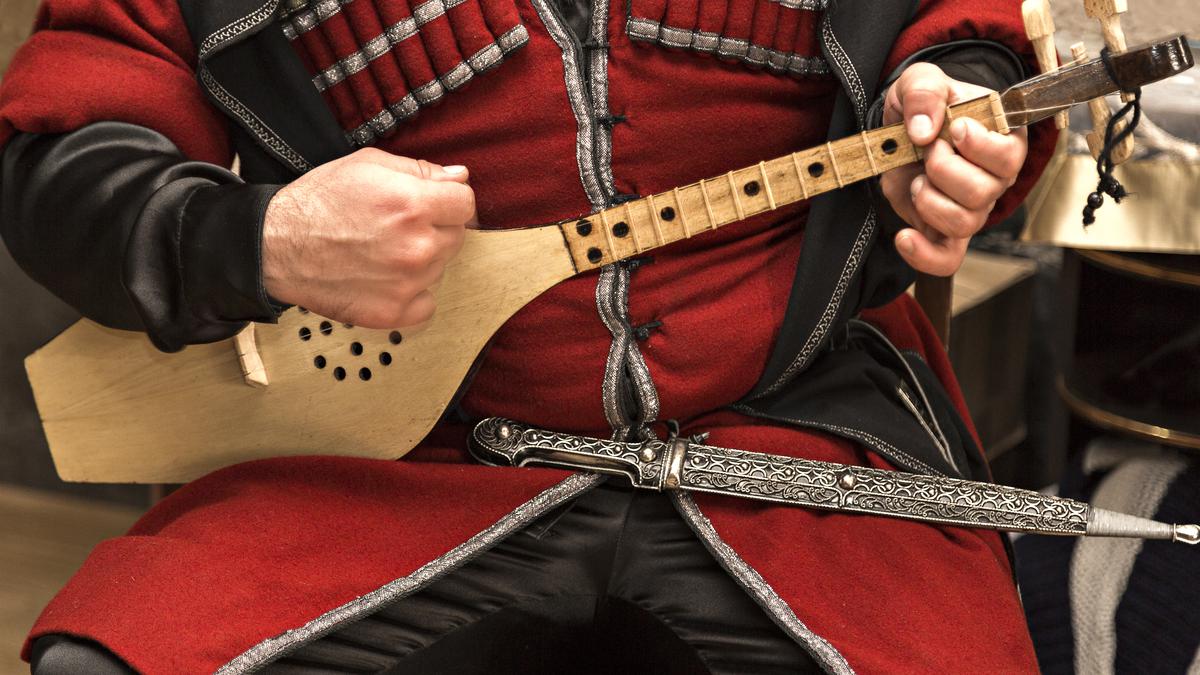
The uniqueness of musical instruments in Georgia
Unique musical instruments of Georgia
«If we think that the duduk is only Armenian, then we are mistaken. Yes, the homeland of the duduk is Armenia, but when Armenians played it while living here, in Georgia, over time its sound changed, and it became like a Georgian instrument. The doli, for example, exists in both the Georgian and Armenian cultures. But the Armenian dhol is completely different. It is made differently, and the type of skin and wood used to make it matters. In Turkey, there are also instruments that are very similar to Georgian ones. It's normal, neighboring relationships also work in music,», – says David Tsinadze.
Armenian duduk is made from apricot tree wood, while in Georgia it's made from mulberry tree wood. If a person plays one instrument, it's easier for them to learn to play other instruments as well.
«Each instrument is unique, each has its own music. It may seem that they are similar, but that is not the case,», – says David Tsintsadze.
In Georgia, the younger generation has recently started to study the craft of making folk instruments. And all of them, without exception, claim that Georgian musical instruments are unique. Yes, of course, there are similarities with instruments from other countries, but each instrument has its own twist that no one else has.
Musical instruments were regular guests at any celebration. With their help, guests were entertained, sang folk songs together, and danced. By the way, musical instruments were not always used for happy celebrations, they also actively participated in the sad moments of Georgian families' lives.
There is a museum of Georgian folk instruments in Tbilisi. It was created in 1975 based on a private collection of musical instruments by Arkady Revazishvili. Anyone interested in Georgian culture and history can visit it and see antique exhibits with their own eyes. Many tourists have visited the museum more than once and have always been impressed.
Let's take a look at the national musical instruments that were used in the past on the territory of Georgia.
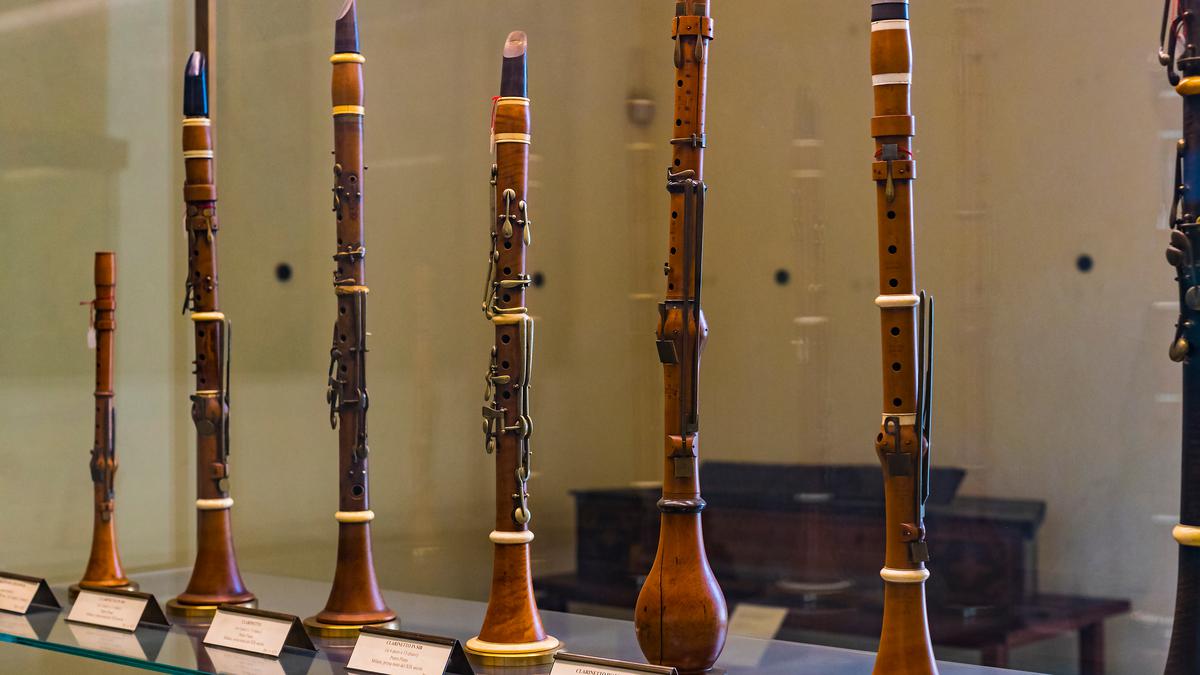
Wind musical instruments
- Duduks
- Salamuri
- Gudastviri
Duduks are Georgian flutes that are very popular throughout Georgia. They are played both as solo parts and as an accompaniment to other instruments. The duduk consists of a barrel, a reed, a regulator, and a cap. The main difference between the duduk and other similar flutes is its soft sound. The duduk is also popular outside of Georgia, but in other cultures, it has undergone minor changes, allowing it to become a new instrument.
Salamura is a type of flute that was an integral part of the shepherds' equipment. There are two techniques for playing the salamura: tongue and tongueless. It all depends on the instrument itself: the tongue technique is applicable only if the flute has a reed. Salamura is widely spread throughout the eastern territory of Georgia. Its peculiarity is that only men are allowed to play it.
Gudastviri is considered a distant Georgian relative of the bagpipe. Gudastviri is made from sheepskin, sewn into a bag, and a bull or deer horn. It is also allowed to be played only by men. Gudastviri is not used as a solo instrument; it acts as an accompaniment to other instruments for performing dance music. It is called differently in different places: in Adjara - Chiboni, in Racha - Stviri, and in Meskheti - Tulumi.
- Pilili
- Zurna
- Buki
Pilili - an Adjarian flute about 30 centimeters long, used to perform dance and playful melodies. It is also often used in tournaments to cheer up opponents. Usually played in ensembles with other musical instruments. It consists of a pipe stem and a reed. The stem has 5 to 7 holes, and the length of the reed depends on the desired sound. Made of elderberry, plum, or bamboo.
Zurna - an Adjarian festive flute with a double reed. It looks like a tube with 8 holes on one side of the stem and one on the opposite side. It produces a bright and piercing sound in a range of 1.5 octaves. Often played in an ensemble of three instruments together with percussion. In enclosed spaces, due to its sharp sound, zurna is often replaced with duduk. The overall length is about 30 centimeters, and the diameter of the bottom end reaches 6 cm.
Bukhi - a military brass instrument in the form of a whistle, up to 127 centimeters high, with the main funnel diameter of 22 cm. In the past, it was used on campaigns to sound a warning signal. When the soldiers approached, the musicians produced a deafening sound, thus warning their compatriots. Nowadays, it is rarely used, but still listed as one of Georgia's military instruments.
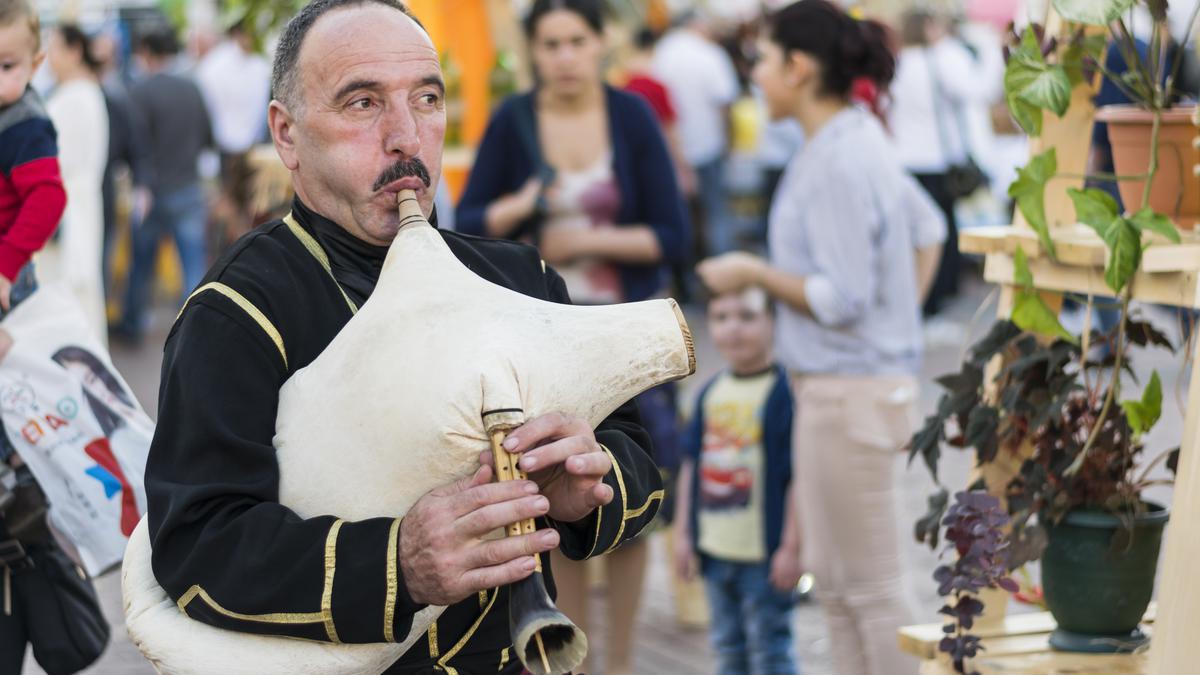
Stringed musical instruments
In the group of string instruments, there are two subgroups: plucked (manual) and bowed.
Plucked instruments are those where the sound is produced by plucking and sliding fingers along the strings. This subgroup includes such instruments as:
- Panduri;
- Chonguri.
Panduri is a stringed musical instrument that is widely popular in the eastern part of Georgia. The appearance of the panduri resembles half of a pear, sometimes with trimmed sides and an elongated branch. Panduri is made from a part of a whole tree. It consists of a body with stretched strings, a neck (fingerboard), and other various elements that serve a decorative function. Panduri is used as an accompaniment or a solo instrument to perform lyrical ballads, poems, and legends that celebrate historical heroes of Georgia. Chonguri is a four-stringed musical instrument that is very similar to panduri in its design but surpasses it in quality of sound and wide harmonic possibilities. Chonguri is made using the same principle as panduri: a body with stretched strings, a neck (fingerboard), and additional elements.
These two musical instruments, in addition to their participation in Georgian celebrations, are also sold in the market as souvenirs. They are only slightly more expensive than mundane magnets, dishes, or small figurines. One of these purchased musical instruments will be a significant gift for your loved ones or a great reminder of the days spent in beautiful Georgia for you.
Bowed instruments are those where the sound is produced by smooth movements of a bow across the strings. The subgroup of bowed instruments includes:
- Chuniri;
- Chianuri.
Chuniri, like other stringed instruments, has an oval-shaped body, strings stretched over it, a neck, and various additional details. Unlike plucked instruments, Chuniri is played with a bow. Interestingly, in eastern Georgia, it is called Chuniri, and in the west, it is called Chianuri. Today, Chuniri can be seen thanks to the highlanders who have preserved it in its pristine state. Some tourists claim that in the evenings, in the mountains, you can hear someone skillfully playing this musical instrument.
Keyboard musical instruments
Among the keyboard instruments of Georgia, two types stand out:
- Buzika;
- Tiko-Tiko.
Both musical instruments are not native to Georgian culture, as they were not invented on Georgian territory, but over the course of two hundred years, they managed to take root and contribute to the development of Georgian music.
Buzika - the first on our list - is a female musical instrument.
It is a small accordion. Buzika was often given as a gift to the bride during the engagement ceremony. In many families, girls are taught to play this instrument from childhood.
Tiko-Tiko migrated to the Georgian people from Europe in the 19th century.
It looks like a small accordion, very similar to a harmonica. Tiko-Tiko is mainly used at Georgian festivals, during lively and energetic dances, and can often be found at weddings.
The accordion or harmonica is difficult to classify as a truly Georgian musical instrument, but they became particularly popular among the local population in the 1830s. The tradition of playing the accordion during dances, family celebrations, and ceremonies came from Russia.
Today, in the northeast of Georgia, namely in Tusheti, residents love to use the harmonica for accompaniment or to perform solo parts. Be sure to listen to the songs "Mtiuluri", "Shen Mahvel", and "Rachin Dance Melody" to appreciate the beauty of Georgian accordion playing.
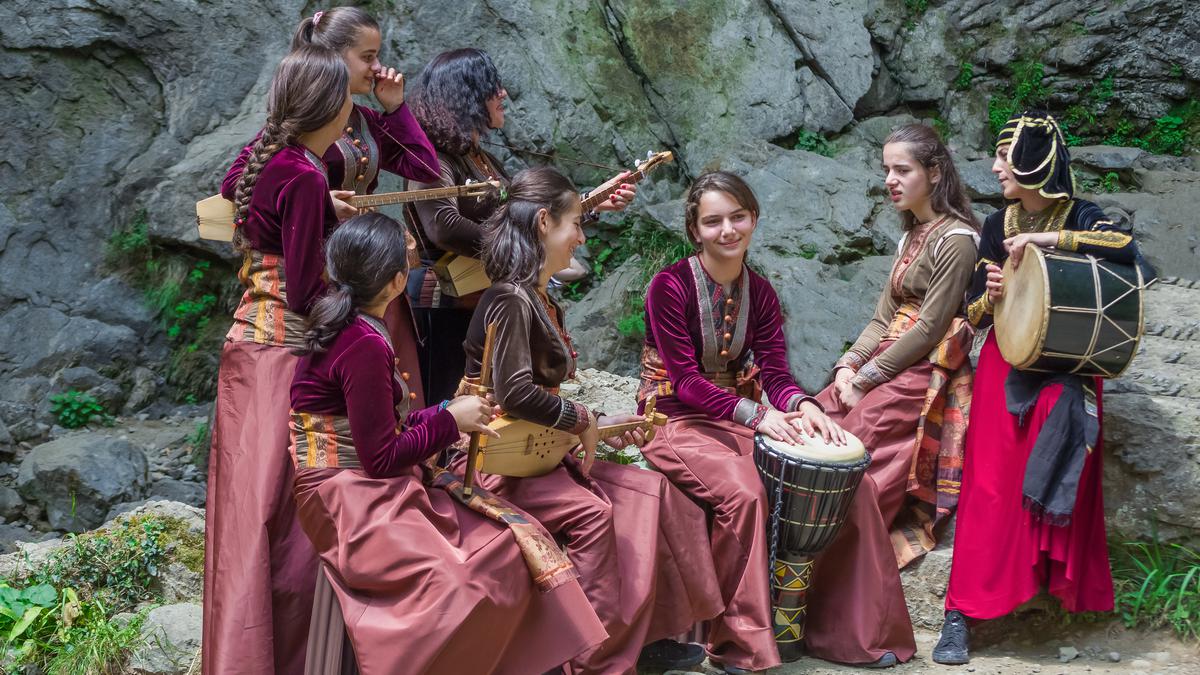
Percussion musical instruments
Nothing sets the rhythm quite like percussion instruments. The sound of strikes helps to move in time with lively music. There are three national percussion instruments in Georgia:
- Doli;
- Daira;
- Cinzila.
Doli is a percussion instrument that consists of a double-sided wooden cylinder covered with skin. This design is created using metal hoops that are fastened to the body with leather straps. Sound is produced by striking both membranes with palms, fingers, or special sticks.
Daira is a musical instrument that has existed in Georgia for many years. It is widely used in the regions of Samegrelo and Racha in western Georgia, in the valley of eastern Georgia, and in the mountain region of Tusheti. It is often used during weddings and other joyful musical events. Daira looks like a round wooden tambourine, tightly covered with skin, with attached metal suspensions on the inner side. When struck, it produces a dull sound accompanied by the jingling of the suspensions. Daira is held in both hands during the game. The big fingers press against the circle, while the other fingers strike the sound-reproducing surface. The fingers of the left hand are hardly involved.
Cinzili is an ancient musical instrument that looks like ordinary cymbals, which have a sound-distributing belt and a loop for a handle. The cymbals are perforated in a circle. They play the role of sound distributors. This instrument is often used today as well. When comparing ancient Cinzili, found during excavations, and modern ones, it was found that the ancient ones were much louder, which is not surprising since they were used in military campaigns, and striking them meant that the troops were ready for battle. This instrument was mentioned earlier in Georgian literature, for example, in the work "The Knight in the Panther's Skin." In addition to this instrument, other metal instruments such as lines, drums, and others have also been found.
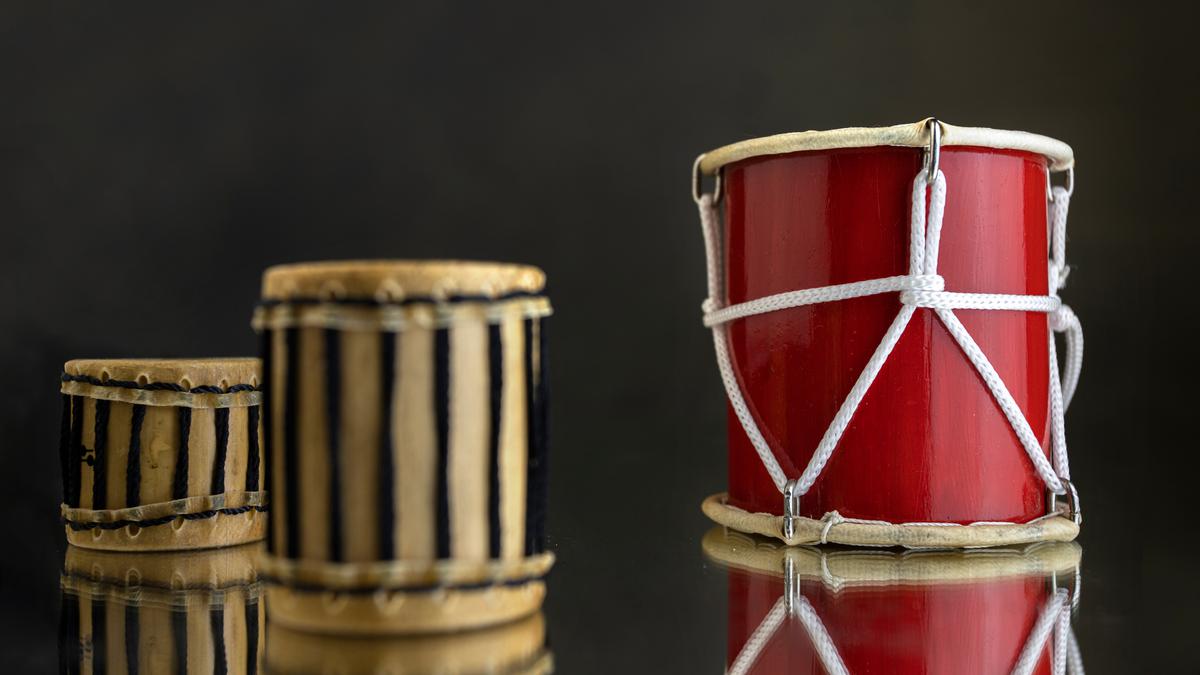
Conclusion
Georgia is a well-developed country with a very rich and interesting history of culture and way of life. Citizens have a special love for their spiritual heritage. Throughout the territory of this beautiful country, there are many different cultural objects, a significant part of which is made up of musical instruments.
With all spheres of life in Georgia, anyone can familiarize themselves with numerous museums, mostly located in the city of Tbilisi.
On the expanses of the Internet, you can easily find and listen to how all these musical instruments sound. And if you want to see them with your own eyes, hear their live sound, touch or maybe play them, we advise you to go to Georgia. Don't forget to visit the Tbilisi State Museum of Folk Instruments. Its walls house a unique collection of folk musical instruments collected by Arkady Revazishvili.
The museum presents both working exhibits and images of objects that have yet to be included in the museum. If you have already heard a melody played on Georgian musical instruments, write to us in the comments about how it was. Share your impressions of what you heard and saw with our readers!












13 comments
Log in to leave a comment
Безусловно в мире современных технологий живая музыка имеет свою ценность и, я бы сказала, душевность. Хотелось бы услышать грузинский ансамбль вживую.